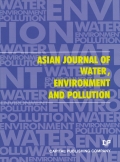Authors: Jänen, Ingo | Adi, Seno | Jennerjahn, Tim C.
Article Type:
Research Article
Abstract:
The Brantas River is a tropical mid-sized river with mountainous headwaters, covering a catchment area of around 11,050 km^2 at the east coast of Java, Indonesia. Its watershed is located in one of the most densely populated regions worldwide, facing alterations by agriculture, urbanization and aquaculture ponds. Additionally, one of the two major distributaries of the Brantas River in the lowlands, the Porong River is affected by inputs from the "LUSI" mud volcano since
…April 2006. We investigated spatio-temporal variations in inorganic nutrient biogeochemistry of the Brantas River, its major distributaries in the lower reaches and its coastal-estuarine regions and related them to land use and hydrology. Highest nutrient loadings occurred during the wet periods (November to April) making up 80% and 87% of the annual dissolved inorganic nitrogen (DIN: NO_3^- , NO_2^- , NH_4^ + ) and phosphorus (PO_4^{3-} ) loads, respectively, with the Porong River accounting for 90% and 82% of the annual DIN and PO_4^{3-} input. During wet periods the estuaries were flushed with DIN and PO_4^{3-} rich freshwater, leading to high concentrations in coastal waters. Much lower nutrient concentrations were observed in coastal waters during dry periods because of low river discharge and nutrient load. During dry periods an increased exchange time and increased biological activity were responsible for estuaries acting as a sink for NO_3^- and a source for NH_4^ + and PO_4^{3-} . In contrast, during wet periods most of the introduced NO_3^- was directly discharged into coastal waters without further processing and NH_4^ + and PO_4^{3-} fluxes were slightly lower. Variations in the DIN composition were mainly related to differences in land use with NO_3^- dominating the agriculture-dominated upper Brantas River and increasing NH_4^ + and NO_2^- content in the lower reaches affected by urban wastewater and aquaculture. The mud volcano affected parts of the Porong River showed drastic changes in the DIN composition and depletion of dissolved oxygen during low flow periods. In contrast, during wet periods most of the mud volcano input was diluted by the large freshwater and inorganic nutrient supply from the upstream regions. Our results suggest that the densely urbanized Brantas River with multiple anthropogenic nutrient sources (agriculture, urban sewage release, aquacultures) leads to an increased export of dissolved inorganic nitrogen and phosphorus into coastal waters. The enhanced nutrient export supports nutrient enrichment in coastal waters, can possibly affect the phytoplankton production and composition, leading to eutrophication within nearshore regions of the Madura Strait.
Show more
Keywords: Nutrients, budget, eutrophication, biogeochemistry, environmental change, land use, Indonesia
Citation: Asian Journal of Water, Environment and Pollution,
vol. 10, no. 1, pp. 73-93, 2013
Price: EUR 27.50





